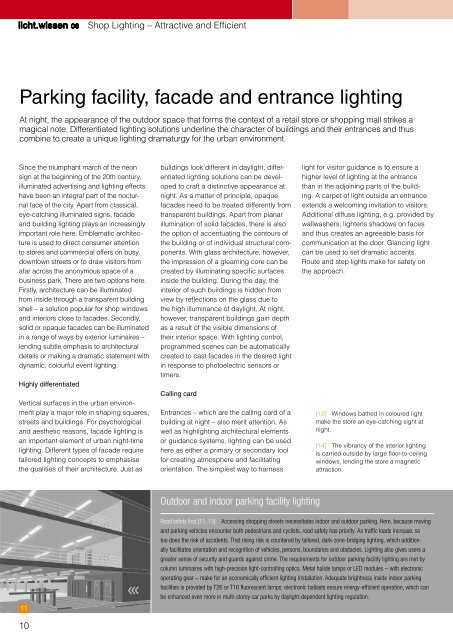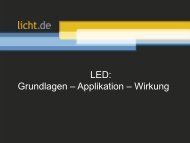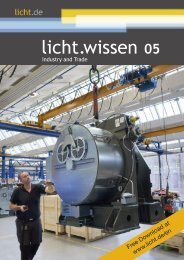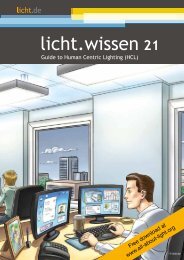licht.wissen No. 06 "Shop Lighting - Attractive and Efficient"
licht.wissen 06 provides a practical and user-oriented summary of attractive and efficient shop lighting. More information about professional lighting: www.licht.de/en
licht.wissen 06 provides a practical and user-oriented summary of attractive and efficient shop lighting. More information about professional lighting: www.licht.de/en
Create successful ePaper yourself
Turn your PDF publications into a flip-book with our unique Google optimized e-Paper software.
<strong>licht</strong>.<strong>wissen</strong> <strong>06</strong><br />
<strong>Shop</strong> <strong>Lighting</strong> – <strong>Attractive</strong> <strong>and</strong> Efficient<br />
Parking facility, facade <strong>and</strong> entrance lighting<br />
At night, the appearance of the outdoor space that forms the context of a retail store or shopping mall strikes a<br />
magical note. Differentiated lighting solutions underline the character of buildings <strong>and</strong> their entrances <strong>and</strong> thus<br />
combine to create a unique lighting dramaturgy for the urban environment.<br />
Since the triumphant march of the neon<br />
sign at the beginning of the 20th century,<br />
illuminated advertising <strong>and</strong> lighting effects<br />
have been an integral part of the nocturnal<br />
face of the city. Apart from classical,<br />
eye-catching illuminated signs, facade<br />
<strong>and</strong> building lighting plays an increasingly<br />
important role here. Emblematic architecture<br />
is used to direct consumer attention<br />
to stores <strong>and</strong> commercial offers on busy<br />
downtown streets or to draw visitors from<br />
afar across the anonymous space of a<br />
business park. There are two options here.<br />
Firstly, architecture can be illuminated<br />
from inside through a transparent building<br />
shell – a solution popular for shop windows<br />
<strong>and</strong> interiors close to facades. Secondly,<br />
solid or opaque facades can be illuminated<br />
in a range of ways by exterior luminaires –<br />
lending subtle emphasis to architectural<br />
details or making a dramatic statement with<br />
dynamic, colourful event lighting.<br />
Highly differentiated<br />
Vertical surfaces in the urban environment<br />
play a major role in shaping squares,<br />
streets <strong>and</strong> buildings. For psychological<br />
<strong>and</strong> aesthetic reasons, facade lighting is<br />
an important element of urban night-time<br />
lighting. Different types of facade require<br />
tailored lighting concepts to emphasise<br />
the qualities of their architecture. Just as<br />
buildings look different in daylight, differentiated<br />
lighting solutions can be developed<br />
to craft a distinctive appearance at<br />
night. As a matter of principle, opaque<br />
facades need to be treated differently from<br />
transparent buildings. Apart from planar<br />
illumination of solid facades, there is also<br />
the option of accentuating the contours of<br />
the building or of individual structural components.<br />
With glass architecture, however,<br />
the impression of a gleaming core can be<br />
created by illuminating specific surfaces<br />
inside the building. During the day, the<br />
interior of such buildings is hidden from<br />
view by reflections on the glass due to<br />
the high illuminance of daylight. At night,<br />
however, transparent buildings gain depth<br />
as a result of the visible dimensions of<br />
their interior space. With lighting control,<br />
programmed scenes can be automatically<br />
created to cast facades in the desired light<br />
in response to photoelectric sensors or<br />
timers.<br />
Calling card<br />
Entrances – which are the calling card of a<br />
building at night – also merit attention. As<br />
well as highlighting architectural elements<br />
or guidance systems, lighting can be used<br />
here as either a primary or secondary tool<br />
for creating atmosphere <strong>and</strong> facilitating<br />
orientation. The simplest way to harness<br />
light for visitor guidance is to ensure a<br />
higher level of lighting at the entrance<br />
than in the adjoining parts of the building.<br />
A carpet of light outside an entrance<br />
extends a welcoming invitation to visitors.<br />
Additional diffuse lighting, e.g. provided by<br />
wallwashers, lightens shadows on faces<br />
<strong>and</strong> thus creates an agreeable basis for<br />
communication at the door. Glancing light<br />
can be used to set dramatic accents.<br />
Route <strong>and</strong> step lights make for safety on<br />
the approach.<br />
[12] Windows bathed in coloured light<br />
make the store an eye-catching sight at<br />
night.<br />
[14] The vibrancy of the interior lighting<br />
is carried outside by large floor-to-ceiling<br />
windows, lending the store a magnetic<br />
attraction.<br />
Outdoor <strong>and</strong> indoor parking facility lighting<br />
11<br />
Road safety first [11, 13]: Accessing shopping streets necessitates indoor <strong>and</strong> outdoor parking. Here, because moving<br />
<strong>and</strong> parking vehicles encounter both pedestrians <strong>and</strong> cyclists, road safety has priority. As traffic loads increase, so<br />
too does the risk of accidents. That rising risk is countered by tailored, dark-zone-bridging lighting, which additionally<br />
facilitates orientation <strong>and</strong> recognition of vehicles, persons, boundaries <strong>and</strong> obstacles. <strong>Lighting</strong> also gives users a<br />
greater sense of security <strong>and</strong> guards against crime. The requirements for outdoor parking facility lighting are met by<br />
column luminaires with high-precision light-controlling optics. Metal halide lamps or LED modules – with electronic<br />
operating gear – make for an economically efficient lighting installation. Adequate brightness inside indoor parking<br />
facilities is provided by T26 or T16 fluorescent lamps; electronic ballasts ensure energy-efficient operation, which can<br />
be enhanced even more in multi-storey car parks by daylight-dependent lighting regulation.<br />
10

















